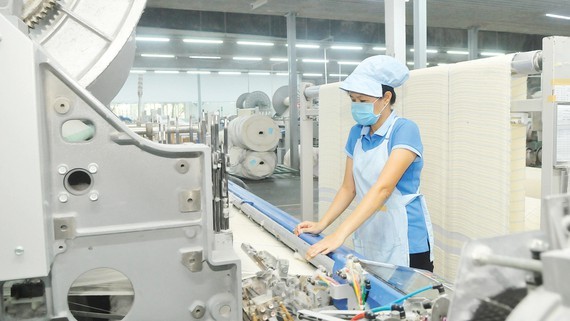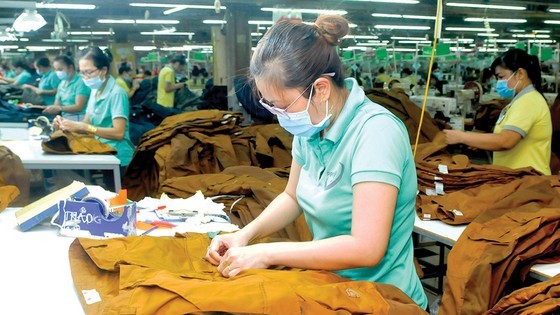 Production at Phong Phu Joint Stock Company in Thu Duc City. (Photo: SGGP)
Production at Phong Phu Joint Stock Company in Thu Duc City. (Photo: SGGP)
The service industry takes the lead
According to the report of the Statistics Office of HCMC, the total State budget revenue in the first six months of this year is estimated at more than VND198.56 trillion, as much as 55.7 percent of the estimate, up 20.7 percent over the same period. Of which, domestic revenue is more than VND136.36 trillion, as much as 55.7 percent of the estimate, up 19 percent; revenue from crude oil is nearly VND6.81 trillion, accounting for 79.6 percent of the estimate, up 6.8 percent; revenue from import-export activities is VND60.2 trillion, accounting for 55.7 percent of the estimate, up nearly 25 percent over the same period.
The Covid-19 pandemic has negatively impacted the growth of many industries. However, the development of the trade-in service sector has helped to recoup the growth. Specifically, the trade-in service sector rose by 5.86 percent while it increased by 0.67 percent in the same period last year. Three service industries posted high growth include trade with an increase of 6.01 percent over the same period, transportation and warehousing with 5.73 percent, and finance, banking, and insurance with 8.22 percent. Besides, the added-value of nine key service sectors accounted for more than 58 percent of the GRDP and 91.3 percent of the service sector.
Although the industry contributed only 0.8 percentage points to the overall growth of the city's economy, the first six months of this year achieved a growth rate of 4.16 percent, doubling that in the same period last year, meaning that the industry has shown signs of recovery. The construction industry alone grew by only 0.98 percent, lower than the growth of 1.17 percent in the same period because of interrupted construction projects, limited supply of housing products, and increasing construction material prices.
According to the report of the Statistics Office of HCMC, the total State budget revenue in the first six months of this year is estimated at more than VND198.56 trillion, as much as 55.7 percent of the estimate, up 20.7 percent over the same period. Of which, domestic revenue is more than VND136.36 trillion, as much as 55.7 percent of the estimate, up 19 percent; revenue from crude oil is nearly VND6.81 trillion, accounting for 79.6 percent of the estimate, up 6.8 percent; revenue from import-export activities is VND60.2 trillion, accounting for 55.7 percent of the estimate, up nearly 25 percent over the same period.
The Covid-19 pandemic has negatively impacted the growth of many industries. However, the development of the trade-in service sector has helped to recoup the growth. Specifically, the trade-in service sector rose by 5.86 percent while it increased by 0.67 percent in the same period last year. Three service industries posted high growth include trade with an increase of 6.01 percent over the same period, transportation and warehousing with 5.73 percent, and finance, banking, and insurance with 8.22 percent. Besides, the added-value of nine key service sectors accounted for more than 58 percent of the GRDP and 91.3 percent of the service sector.
Although the industry contributed only 0.8 percentage points to the overall growth of the city's economy, the first six months of this year achieved a growth rate of 4.16 percent, doubling that in the same period last year, meaning that the industry has shown signs of recovery. The construction industry alone grew by only 0.98 percent, lower than the growth of 1.17 percent in the same period because of interrupted construction projects, limited supply of housing products, and increasing construction material prices.
 Production at Phong Phu Joint Stock Company in Thu Duc City. (Photo: SGGP)
Production at Phong Phu Joint Stock Company in Thu Duc City. (Photo: SGGP)
At the same time, trade and retail activities saw high growth. Specifically, the total retail sales of consumer goods and services in the first six months is estimated at more than VND541.68 trillion, up 7.3 percent over the same period.Capital poured sharply into the economy In the first six months of the year, the whole city had 18,441 newly registered enterprises with a total registered capital of nearly VND310.99 trillion, an increase of 3.8 percent in volume and 39.2 percent in value. Nine major service industries had a high number of newly-established enterprises with up to 13,513 enterprises, accounting for 73.2 percent, and registered capital exceeded VND197.76 billion, up 23.9 percent over the same period last year. On the opposite direction, in general, foreign direct investment (FDI) attraction decreased. In the first six months, the city attracted 262 new projects with a total registered capital of US$264.4 million, 75 times of projects adjusting investment capital with a total of $475.3 million, 1,040 times of capital contribution, and purchase of shares with a total value of $686 million. Thus, the total registered capital for newly licensed capital, adjusted capital, capital contribution, and share purchase merely touched $1.43 billion, down nearly 30 percent over the same period. Besides, the total realized social investment capital is estimated at more than VND185.97 trillion, up 6 percent year-on-year, accounting for 27.3 percent of GRDP. Meanwhile, it decreased by 10.1 percent in the same period last year. Specifically, the capital of the State-owned sector reached VND23.85 trillion, the non-State sector roughly VND135.36 trillion, and the FDI sector VND26.76 trillion. As for the disbursement of public investment capital, although it has been half a year, the disbursement rate only reached 25 percent of the assigned capital plan, equivalent to VND9.09 trillion, while the set target was over 50 percent.
According to a report by the Statistics Office of HCMC, the total export turnover of HCMC-based enterprises through the city ports, including crude oil, is estimated at above $20.34 million in the first six months, up 5.6 percent year-on-year. There are five groups of goods with an export value of over $1 billion, accounting for 75 percent of total export turnover. They include computers, electronic products, and components with $7.7 billion, accounting for 38.1 percent, other commodity groups with $3.6 billion, accounting for 17.9 percent, garments, and textiles with $1.6 billion, accounting for 8.1 percent, machinery, equipment, tools, and spare parts with $1.13 billion, accounting for 5.5 percent, and footwear products with $1.1 billion, accounting for 5.4 percent.
























